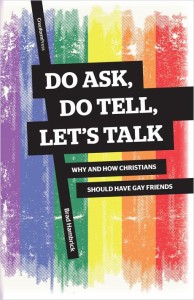 In this second post (the first one is here), I want to introduce you to the kinds of questions addressed in my book Do Ask, Do Tell, Let’s Talk (which releases tomorrow). To help make the rest of this post clearer, I’ll start by summarizing chapter one, which among other things gives us the vocabulary we need to speak wisely and accurately about this challenging subject.
In this second post (the first one is here), I want to introduce you to the kinds of questions addressed in my book Do Ask, Do Tell, Let’s Talk (which releases tomorrow). To help make the rest of this post clearer, I’ll start by summarizing chapter one, which among other things gives us the vocabulary we need to speak wisely and accurately about this challenging subject.
Chapter One: “Language, Stigma, and Expectations” What is the difference between experiencing same-sex attraction, engaging in homosexual behavior, and embracing a gay identity? How do these categories help Christians speak from a conservative sexual ethic without shutting down conversation? What are the words, logic, and ways of speaking that immediately designate us “unsafe” for those who experience same-sex attraction? When two people who have a vested interest in conflicting value systems talk, what are some healthy, realistic expectations for that conversation? How can the church be a safe place for these conversations, so that there is an alternative to “coming out” as gay?
In fact, my greatest hope is that this book will help equip the church to be a place where testimonies like these can become increasingly frequent:
- An individual who embraces a gay identity could say, “I have friends who are Christians and disagree with my chosen lifestyle but love me well. I believe they would gladly help me if I had a need.”
- A teenager who is beginning to experience same-sex attraction could say, “I have Christian friends who understand what I’m facing and care enough to help me think through this confusing experience.”
- Parents of a child who is experimenting with homosexual behaviors could say, “Our small group cared for us well and helped us think through how to love our son. It was surprising how safe we felt to wrestle with the questions we were facing.”
- An individual who was considering leaving the gay lifestyle could say, “The Christians that I knew while I was openly gay were a big part of the reason I may choose to pursue what I now believe to be God’s design for sexuality.”
If these statements reflect how you think conversations about homosexuality should be happening in the church, I believe you’ll find Do Ask, Do Tell, Let’s Talk to be helpful. Let’s continue now with the chapter summaries.
Chapter Two: “Being Comfortable Being Uncomfortable” Talking about sex is awkward enough. If we believe that Romans 1 is the only road to homosexuality (namely, progressive sexual depravity), then we respond to individuals who experience same-sex attraction as if they were the equivalent of sex addicts and pedophiles. Our ignorance of the same-sex attraction experience heightens the awkwardness of these conversations and increases the likelihood that we will be unintentionally offensive. This chapter examines the common internal obstacles to being a mature, informed participant in conversations with friends or family members who experience same-sex attraction (SSA).
Chapter Three: “Getting to Know the Experience of SSA” What is it like to realize that your experience of romantic attraction is different from that of most people? What are the common markers in the journey of individuals who experience same-sex attraction, and what emotions accompany those markers? What is it like to “know” that your attractions cannot be talked about “at church” but other people’s can? How would that dynamic influence your experience of Christianity and culture in general? An appreciation for these questions is vital to being a good friend (while not necessarily agreeing with your friend’s conclusions).
Chapter Four: “Getting to Know the Person Experiencing SSA” An appreciation for chapter three does not mean you know the experience of any particular individual. Knowledge about a subject without knowledge of a person is more debate-prep than relationship. This chapter will provide good questions to ask based upon the content of chapter three, and give guidance so that when SSA comes to the forefront of conversation, we don’t reduce an individual to this one characteristic.
Chapter Five: “Winning an Argument vs. Influencing a Friend” A cliché or gotcha line never transformed anyone’s sexuality. They get applause from those who agree with you and disdain from those who don’t. They polarize. What should be our tone and emphasis when discussing biblical passages on homosexuality? How early in a relationship do I need to bring up these passages in order to be a faithful Christian? Is it profitable to discuss things like research biases in genetic findings related to homosexuality? If so, then how, when, and for what purpose? At what point does protecting a friendship for the sake of influence become moral compromise?
Chapter Six: “Navigating Difficult Conversations” Tricky interpersonal issues can arise in this area. Will you come to my wedding? Shouldn’t my parents allow me and my partner to come over for Christmas? Am I not supposed to be hurt by Christians who say things they deem to be true, but say them in attacking and demeaning ways? If I do not experience any, or very limited, opposite-sex attraction, do I have to remain celibate my entire life to be a Christian? These and other subjects are addressed through an annotated dialogue that helps the reader think through what it would be like to have conversations about what they’ve read with someone who experiences same-sex attraction.